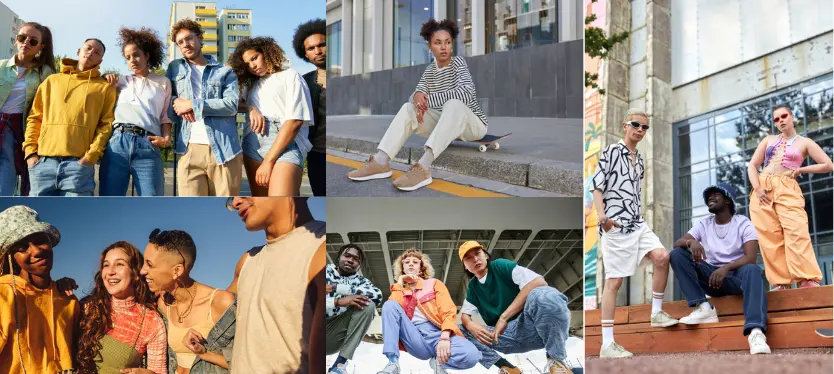In the realm of style, streetwear has transcended its humble beginnings to end up a dominant force inside the industry. What once originated from the streets as a form of rebellion and self-expression among city teenagers has now advanced into a global phenomenon, influencing high-cease dressmaker collections and shaping mainstream style developments. Let’s take a better study of the evolution of the streetwear lifestyle, its roots, its effect, and its enduring effect on the style panorama.
Origins of Streetwear: Rebellion and Authenticity
The Birth of Streetwear
Streetwear emerged within the Nineteen Seventies and Nineteen Eighties, ordinarily in city centers like New York City and Los Angeles. It changed born out of the fusion of skateboarding, hip-hop, graffiti, and surf cultures. Influenced by the aid of DIY aesthetics and the need for practical garb that could withstand the rigors of avenue existence, streetwear manufacturers began to emerge, catering to the particular fashion possibilities of city young people.
DIY Ethos and Counter-Cultural Roots
At its core, streetwear turned into about authenticity and individuality. DIY ethos changed into conventional, with many streetwear fanatics customizing their apparel to reflect their private style and values. Brands like Stüssy, founded with the aid of Shawn Stussy in the 1980s, and FUBU (For Us, By Us), created through Daymond John in the early Nineties, played pivotal roles in shaping the early streetwear scene, providing options to mainstream fashion that resonated with city teenagers.
Rise to Mainstream: From Subculture to Global Phenomenon
Celebrity Endorsements and Pop Culture
The Nineties marked a substantial turning point for streetwear as it began to gain traction in mainstream lifestyle. Celebrities, particularly hip-hop artists and athletes, performed a critical position in popularizing streetwear manufacturers with the aid of carrying them in tune films, movies, and public appearances. This accelerated visibility catapulted streetwear into mainstream cognizance, transforming it from a culture into a worldwide phenomenon.
Collaborations and High-Fashion Crossovers
Collaborations between streetwear manufacturers and excessive-end style houses similarly blurred the lines between streetwear and comfort style. Iconic collaborations including Nike x Supreme and Adidas x Yeezy delivered together streetwear aesthetics with the status of mounted fashion labels, appealing to a diverse target market starting from sneakerheads to fashion connoisseurs.
Impact on Fashion and Culture
Influence on Design Aesthetics
The influence of streetwear on fashion design cannot be overstated. Its emphasis on consolation, capability, and urban-stimulated aesthetics has permeated the collections of excessive-give-up designers and fast-style shops alike. Elements including graphic prints, outsized silhouettes, and athletic-inspired clothes have become staples in current fashion, reflecting the enduring effect of streetwear on design aesthetics.
Cultural Relevance and Social Commentary
Streetwear has continually been intertwined with broader cultural movements and social remarks. From its roots in internal-city neighborhoods to its international reach nowadays, streetwear continues to function as a platform for self-expression, activism, and cultural trade. Brands often incorporate socio-political topics into their designs, sparking conversations about identity, range, and social justice.
Conclusion: A Continuously Evolving Landscape
From its humble beginnings on the streets of city neighborhoods to its contemporary fame as an international cultural phenomenon, the evolution of streetwear culture reflects the dynamic interaction between style, tradition, and society. As we appear to destiny, streetwear’s effect on design, subculture, and identification will continue to shape the fashion landscape, supplying a platform for creativity, self-expression, and social remarks. In a world that is constantly converting, streetwear remains an undying testimony to the electricity of style as a shape of private and collective expression.
Frequently Asked Questions (FAQs)
Ans. Streetwear is characterized by its casual, city-inspired aesthetic, regularly incorporating factors inclusive of image prints, ambitious logos, and athletic impacts. It emphasizes comfort, capability, and self-expression, drawing suggestions from subcultures like skateboarding, hip-hop, and graffiti.
Ans. Social media structures have played a good sized function in amplifying the visibility and attain of streetwear manufacturers. Platforms like Instagram and TikTok have become hubs for streetwear enthusiasts to show off their fashion, connect to like-minded people, and find out new developments and brands.
Ans. Collaborations between streetwear manufacturers, high-end fashion labels, and artists have emerged as a trademark of the streetwear enterprise. These collaborations no longer generate buzz and pleasure but also provide customers with unique and constrained-version merchandise that blur the lines between streetwear and high style.
Ans. Increasingly, sustainability has emerged as a focal point within the streetwear community, with brands and clients alike in search of extra eco-friendly and ethically produced options. Many streetwear brands are adopting sustainable practices, inclusive of the usage of organic substances, minimizing waste, and supporting truthful labor practices.
Ans. The future of the streetwear subculture is dynamic and ever-evolving. As fashion keeps intersecting with technology, sustainability, and social consciousness, streetwear is possible to adapt and innovate, staying proper to its roots of authenticity and self-expression at the same time as embracing new opportunities for creativity and increase.










Comments are closed